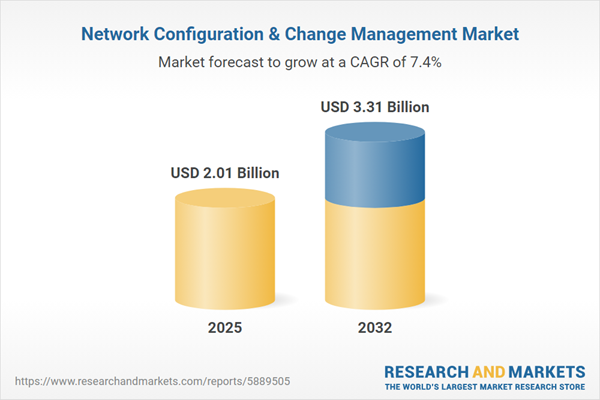Speak directly to the analyst to clarify any post sales queries you may have.
In a fast-evolving digital landscape, secure and agile network configuration and change management have become essential priorities for enterprises seeking to maintain continuous operations and mitigate risk. Senior leaders require holistic solutions that foster compliance, streamline oversight, and sustain business continuity across increasingly complex infrastructure environments.
Market Snapshot: Growth in the Network Configuration & Change Management Market
The network configuration and change management market is undergoing robust expansion, fueled by the need for greater automation and advanced network control in enterprise environments. Valued at USD 1.87 billion in 2024, it is forecast to reach USD 2.01 billion in 2025 and USD 3.31 billion by 2032, reflecting a 7.40% compound annual growth rate.
This growth is driven by the rapid integration of automation, evolving compliance obligations, and increasing alignment of IT infrastructure with modern security standards. Organizations are adopting integrated management platforms and new digital architectures to adapt, manage risks, and optimize network governance in a climate where regulatory requirements are becoming more demanding.Scope & Segmentation: Unlocking Strategic Value in Network Configuration & Change Management
- Deployment Type: Cloud-based solutions, spanning hybrid, private, and public cloud, alongside traditional on-premises models, provide enterprises with flexible integration that matches diverse transformation goals.
- Network Type: Support for both wired and wireless infrastructures equips organizations to secure connectivity, improve operational efficiency, and manage distributed assets across multiple industries.
- Component: Leading providers deliver advanced software platforms, professional consulting, and managed services for real-time automation, network performance optimization, and enhanced visibility into network operations.
- Organization Size: Scalable architectures address the specific needs of large enterprises and small-to-midsize organizations, enabling businesses to overcome unique compliance and operational challenges regardless of scale.
- End-User Industry: Solutions are deployed in sectors including financial services, healthcare, energy, government, manufacturing, retail, telecom, information technology, and transportation, where sector-specific compliance and risk mitigation are crucial.
- Regions: Market adoption spans the Americas, Europe, Middle East and Africa, and Asia-Pacific, influenced by local digital maturity and regulatory landscapes that shape how companies implement network controls.
- Vendor Analysis: Leading vendors such as Cisco Systems, Hewlett Packard Enterprise, SolarWinds Worldwide, Micro Focus International, Juniper Networks, Infoblox, NetBrain Technologies, Zoho Corporation, Tufin Software Technologies, and Device42 emphasize interoperable, integrated tools that support enterprise agility and security requirements.
Key Takeaways: Strategic Insights in Network Configuration & Change Management
- Automation within network management enables faster operational response, streamlining workflows for IT teams and reducing reliance on manual processes.
- Artificial intelligence and policy orchestration tools support stable network operations and rapid adaptation to technology shifts, underpinning enterprise agility.
- Centralized oversight across IT and business divisions enhances enterprise risk management and informed cost allocation during expansion or change.
- Comprehensive management of distributed and edge assets simplifies administration for organizations operating across multiple locations and geographies.
- Robust governance and compliance systems help enterprises manage the complexities of hybrid and multi-cloud environments, easing workloads for IT professionals.
- Vendors support evolving enterprise priorities by introducing modular and resource-efficient technologies that address both sustainability and compliance requirements.
Tariff Impact on Supply Chains and Vendor Strategy
- Rising hardware expenses due to recent US tariffs prompt enterprises to reconsider procurement and supply chain approaches, strengthening the focus on flexibility and resilience.
- The transition to software-defined and virtualized networks reduces dependence on physical equipment and enables organizations to mitigate threats from supply chain disruptions.
- Managed service offerings and varied licensing models from multiple providers bolster procurement adaptability in uncertain market conditions.
- Interoperable network management technologies allow enterprises to respond rapidly to regulatory or commercial shifts, fortifying resilience in unpredictable business environments.
Methodology & Data Sources
Analysis for this report is informed by interviews with network architects, senior IT executives, and technology vendors, and is complemented by a thorough examination of the present regulatory environment. Recommendations and insights are independently validated by subject matter experts to ensure relevance and accuracy for enterprise decision-making.
Network Configuration & Change Management Market: Why This Report Matters
- Empowers senior decision-makers with actionable insights for leveraging automation and artificial intelligence in global-scale network environments.
- Clarifies technology and compliance expectations, equipping organizations to anticipate risks and unlock new opportunities in evolving digital markets.
- Provides strategic guidance needed to design, adapt, and secure network infrastructures for diverse operational and geographic requirements.
Conclusion
Effective network configuration and change management have become cornerstones of resilient digital business. Deploying advanced solutions enables organizations to transform securely while upholding compliance and operational integrity.
Additional Product Information:
- Purchase of this report includes 1 year online access with quarterly updates.
- This report can be updated on request. Please contact our Customer Experience team using the Ask a Question widget on our website.
Table of Contents
3. Executive Summary
4. Market Overview
7. Cumulative Impact of Artificial Intelligence 2025
Companies Mentioned
The companies profiled in this Network Configuration & Change Management market report include:- Cisco Systems, Inc.
- Hewlett Packard Enterprise Company
- SolarWinds Worldwide, LLC
- Micro Focus International PLC
- Juniper Networks, Inc.
- Infoblox, Inc.
- NetBrain Technologies Corporation
- Zoho Corporation Private Limited
- Tufin Software Technologies Ltd.
- Device42, Inc.
Table Information
| Report Attribute | Details |
|---|---|
| No. of Pages | 193 |
| Published | November 2025 |
| Forecast Period | 2025 - 2032 |
| Estimated Market Value ( USD | $ 2.01 Billion |
| Forecasted Market Value ( USD | $ 3.31 Billion |
| Compound Annual Growth Rate | 7.4% |
| Regions Covered | Global |
| No. of Companies Mentioned | 11 |









